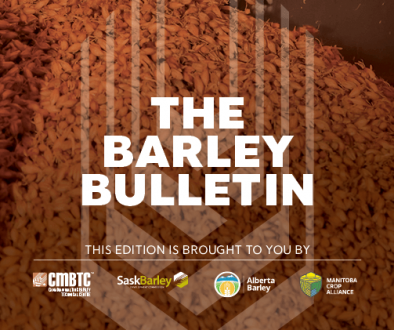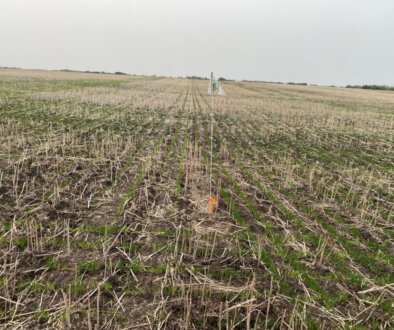CROP PROGRESS REPORT – September 29, 2023
This report may not be reproduced or redistributed in whole or in part without permission of the Canadian Malting Barley Technical Centre.
The barley harvest is into the very final stages in western Canada, ranging from91% finished in Alberta to over 95% complete in Saskatchewan and Manitoba, which is ahead of the normal pace. Overall, the western Canadian grain harvest has seen some delays due to showers in certain areas, although the impact on barley was reduced due to the many of fields having already been completed.
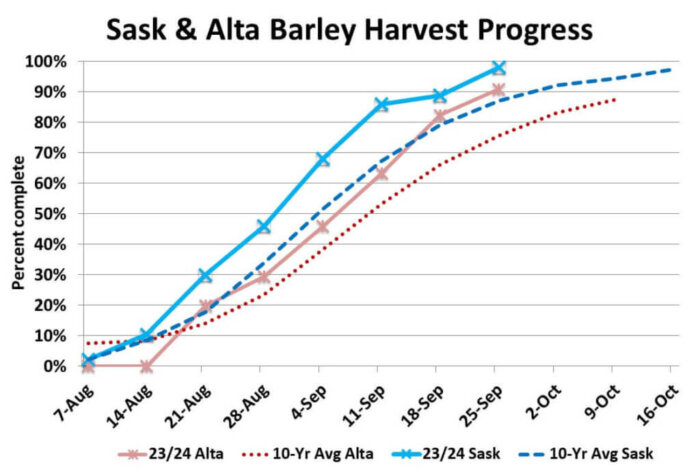
A key factor this season was the limited rainfall across most of western Canada. Aside from a portion of North West Alberta, essentially all the rest of the region saw precipitation far below the historical average. In some cases rainfall was ‘timely’, even if less than what growers would have liked, which helped yields to be relatively better than might be expected if simply looking at the precipitation totals. Even so, the low rainfall did reduce overall production potential.
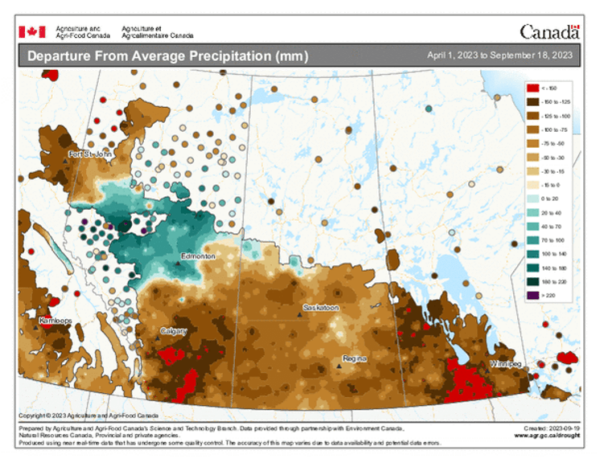
Statistics Canada’s latest 2023 production estimate projected the Canadian barley crop at 7.84 mln tonnes, down slightly from the 7.92 mln tonnes reported previously. This compares to 9.99 mln tonnes in 2022, and a 5-year average of 9.92 mln tonnes. The yield was estimated at 54.8 bu/acre, the second lowest since 2012, and ahead only of that from the severe drought in 2021. It’s possible the final crop size will end up larger than this latest estimate based on provincial yield reports and individual farmer comments.
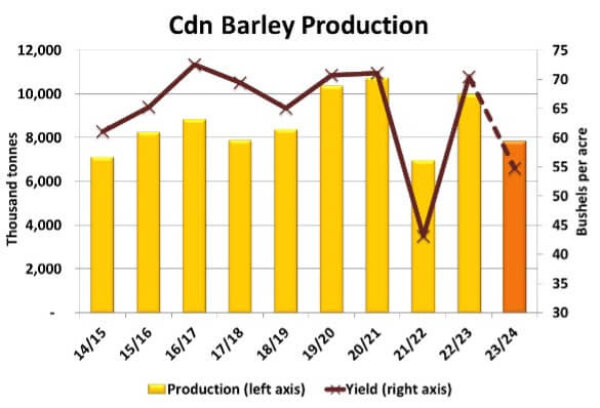
Statistics Canada reported July 31st barley stocks of 708,500 tonnes, which is the official carryout for the 2022/23 season. The is below the 5-year average of 863,400 tonnes, and affirms that supplies were low coming into this latest harvest.
The Canadian Grain Commission released some very early quality results from samples received through their Harvest Sample Program. The figures are based on a small number of samples that were collected early so may not reflect the quality of the malt barley crop as a whole. Proteins are likely higher in these early samples, and test weights lower, than the average of the crop where later harvest barley is likely to have more moderate protein content and higher test weights than suggested by the figures below.
Quality Parameters of Barley Varieties in Western Canada received through the Canadian Grain Commission Harvest Sample Program as of September 8th, 2023

Alberta
The latest Alberta Agriculture crop report as of September 26th showed most of the province’s barley had been harvested, projected at 90.9% complete and with more progress having been made since then. Rain through the summer caused some secondary growth, which resulted in certain fields being harvested later in a few regions. Farmers have tended to see better yields than expected in a number of areas, which caused the government to increase their barley yield to 59.9 bu/acre, an increase of 4.4 bu/acre from a month prior. This is similar to the 61.0 bu/acre yield estimated for the province by Statistics Canada.
The government is reporting 29% of the barley crop being of malt quality, an increase of 6% from their previous estimate. This is roughly in line with the historical average for the province.
Alberta Dryland Yield Estimates as of September 19, 2023
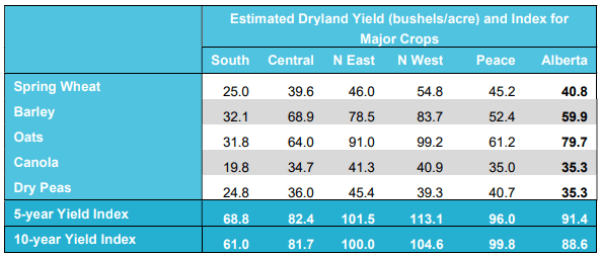
Southern Region (Strathmore, Lethbridge, Medicine Hat, Foremost):
Harvest has been mostly complete in the southern region for some time, particularly for cereals, with barley estimated at 95.1% finished as of September 19. The government is estimating the barley yield in the region at 32.1 bu/acre. However, reports from farmers indicate production varies widely depending on local rainfall. Anecdotal comments suggest individual fields range from below 40 bu/acre to as high as 100 bu/acre.
As expected, quality also varies due to local conditions. This includes reports of protein largely ranging in 13 – 14.5% range for the better fields, but also as high as 17% where crops were severely stressed, which also often coincided with low test weights. The better quality samples were being accepted for malt by local buyers.
Central Region (Rimbey, Airdrie, Coronation, Oyen):
Barley harvest was estimated at 82.7% in the region, with some minor delays due to scattered showers. The regional yield estimate is 68.9 bu/acre. Individual results suggest yields were better than initially expected. In some cases, farmers reported the best production in recent memory, although the region as a whole has been described as ‘average’ for yield and quality. One farm reported an average yield of 118 bu/acre for their Churchill barley and 126 bu/acre for the Sirish.
Farmer samples indicate protein ranged from 9.3% to 11.5% protein, with moisture typically between 12% to 13.5%. One buyer is indicating very little chit seen in the samples they reviewed in the area.
North East Region (Smoky Lake, Vermillion, Camrose, Provost):
The region was estimated to be 74.9% finished the barley harvest after recent favorable weather allowed for rapid progress. The regional barley yield is estimated at 78.5 bu/acre, and malt production has tended to exceed expectations. Most of the crop was harvested in fairly good shape.
North West Region (Barrhead, Edmonton, Leduc, Drayton Valley, Athabasca):
The region is reported as having made the least progress in the barley harvest, estimated at 62.5% finished, as wet conditions have limited access to some fields. However, warm weather is allowing farmers to advance overall. The wetter conditions during the season helped production, with the region estimated to have the highest barley yield in the province at 83.7 bu/acre. One farm reported the yield on their Synergy barley at around 100 bu/acre.
Quality in the region is somewhat mixed due to the conditions during the season, including the impact from rain during the harvest window. This includes some higher levels of chit and somewhat lower germ being reported in later harvested fields. In some cases, this resulted in samples being rejected for malt by buyers, although indications suggest most samples are being accepted.
Southern Region (Strathmore, Lethbridge, Medicine Hat, Foremost):
Harvest has been mostly complete in the southern region for some time, particularly for cereals, with barley estimated at 95.1% finished as of September 19. The government is estimating the barley yield in the region at 32.1 bu/acre. However, reports from farmers indicate production varies widely depending on local rainfall. Anecdotal comments suggest individual fields range from below 40 bu/acre to as high as 100 bu/acre.
As expected, quality also varies due to local conditions. This includes reports of protein largely ranging in 13 – 14.5% range for the better fields, but also as high as 17% where crops were severely stressed, which also often coincided with low test weights. The better quality samples were being accepted for malt by local buyers.
Central Region (Rimbey, Airdrie, Coronation, Oyen):
Barley harvest was estimated at 82.7% in the region, with some minor delays due to scattered showers. The regional yield estimate is 68.9 bu/acre. Individual results suggest yields were better than initially expected. In some cases, farmers reported the best production in recent memory, although the region as a whole has been described as ‘average’ for yield and quality. One farm reported an average yield of 118 bu/acre for their Churchill barley and 126 bu/acre for the Sirish.
Farmer samples indicate protein ranged from 9.3% to 11.5% protein, with moisture typically between 12% to 13.5%. One buyer is indicating very little chit seen in the samples they reviewed in the area.
North East Region (Smoky Lake, Vermillion, Camrose, Provost):
The region was estimated to be 74.9% finished the barley harvest after recent favorable weather allowed for rapid progress. The regional barley yield is estimated at 78.5 bu/acre, and malt production has tended to exceed expectations. Most of the crop was harvested in fairly good shape.
North West Region (Barrhead, Edmonton, Leduc, Drayton Valley, Athabasca):
The region is reported as having made the least progress in the barley harvest, estimated at 62.5% finished, as wet conditions have limited access to some fields. However, warm weather is allowing farmers to advance overall. The wetter conditions during the season helped production, with the region estimated to have the highest barley yield in the province at 83.7 bu/acre. One farm reported the yield on their Synergy barley at around 100 bu/acre.
Quality in the region is somewhat mixed due to the conditions during the season, including the impact from rain during the harvest window. This includes some higher levels of chit and somewhat lower germ being reported in later harvested fields. In some cases, this resulted in samples being rejected for malt by buyers, although indications suggest most samples are being accepted.
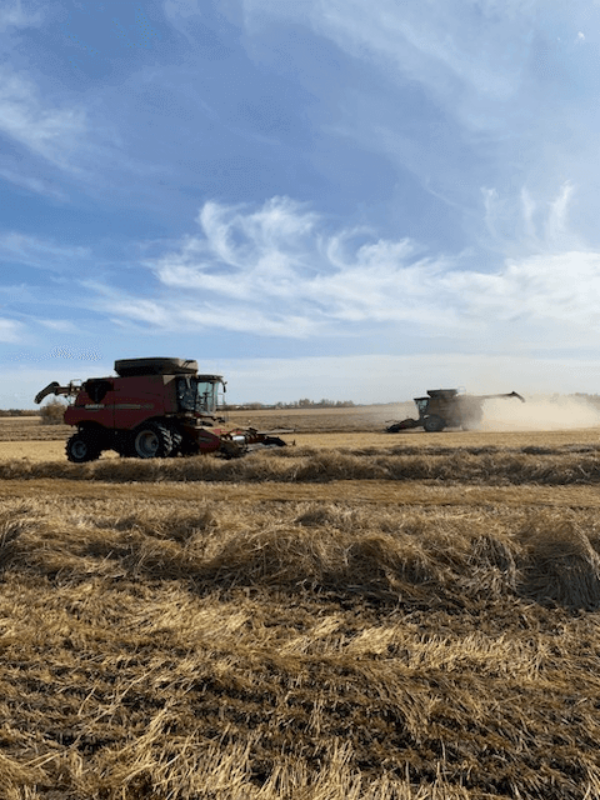
Peace River Region (Fairview, Falher, Grande Prairie, Valleyview):
Barley harvest is well along in the region, at 75% complete. The government estimates the average yield at 52.4 bu/acre, the second lowest in the province. Local results vary widely depending on precipitation amounts. Late rain has resulted in reports of chitting in some of the malt barley samples.
SASKATCHEWAN
The Saskatchewan Ministry of Agriculture’s most recent crop report as of September 18th showed harvest getting into the later stages in the province after a stretch of mostly favorable weather. The barley crop is nearly all off, with farmers now focusing on other crops.
Soil moisture conditions remain low throughout much of the province, particularly in a good portion of the south and western regions. Of course, any precipitation now will not help 2023 production, and farmers would rather avoid significant rain until harvest is complete. But this is an early risk to 2024 production, depending on winter snowfall and rain next spring.
The Saskatchewan government has indicated average provincial barley yields of 52.4 bushels per acre compared with StatCan at 45.1 bu/acre. The difference amounts to nearly half a million tonnes in production, which suggests final StatCan yield and production figures may rise.
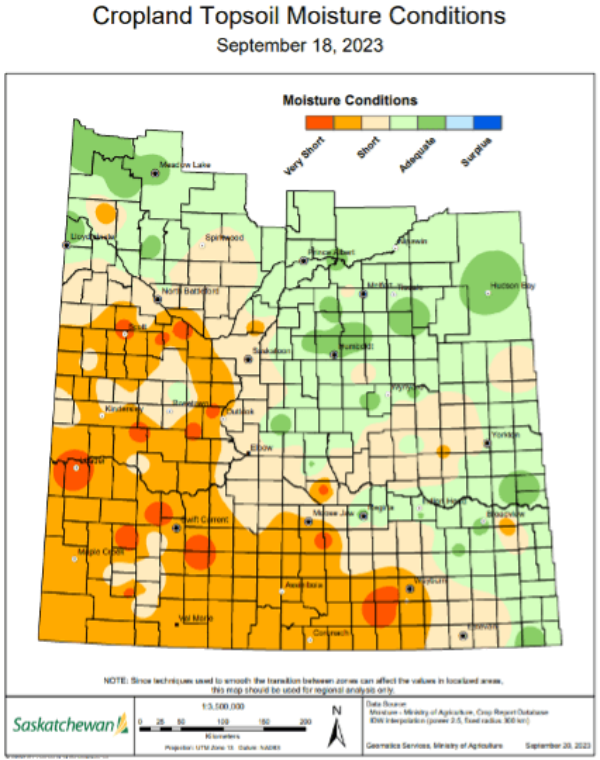
Southeast Region (Moosomin, Weyburn, Moose Jaw, Regina, Qu’Appelle, Minton).
Cereal harvest is nearing completion in the region, including barley at around 93% finished. Barley yields in the region are estimated to be 58 bu/acre. Good spring moisture helped the crop hold up relatively well considering the low rainfall during the season, which resulted in yields that are generally not far below average for the area. Reports suggest the quality of the malt barley crop was good.
East central Regions (Melville, Yorkton, Foam Lake, Lumsden, Watrous, Clavet).
A stretch of favorable weather has allowed farmers to make good harvest progress, including barley, which is estimated to be 82% complete. The province is estimating the average barley yield in the region is 59 bu/acre, although individual reports suggest higher yields are common, including of up to 90 bu/acre or more. There are indications of some quality challenges for fields that didn’t get harvested ahead of the rain, including both heavy chitting and sprouting in certain samples.
Northeast Regions (Tisdale, Melfort, Humboldt, Cudworth, Prince Albert).
Good weather has allowed harvest to advance ahead of the average pace, with barley reported at 97% complete. The government is reporting barley yields in the region averaged 66 bu/acre, the highest in the province, while individual farms are showing yields of 90 – 100 bu/acre.
Quality results in the region are mixed. Barley harvested prior to the rain are showing favorable quality, with protein between 11 – 12.5% and good germ. Results of the crop harvested after the rain are seeing more reports of chitting and sprouting.

Southwest Regions (Assiniboia, Gravelbourg, Swift Current, Maple Creek, Leader).
There is very little harvest left to complete in the region, including barley, which is essentially finished. The province is estimating an average yield in the region of just 25 bu/acre, with results varying depending on local precipitation. The dry conditions have resulted in widespread reports of high protein and low bushel weight.
West central Regions (Outlook, Rosetown, Kindersley, Eston, Wilkie, Biggar).
Harvest is getting into the final stages in the region, with barley estimated to be 97% complete. The government is estimating the average yield in the region to be 45 bu/acre. Farmers are suggesting yields have been better than expected prior to harvest, with quality being variable.
Northwest Regions (North Battleford, Meadow Lake, Maidstone, Lloydminster).
Favorable conditions have allowed harvest to advance ahead of the normal pace in the region. Barley is estimated to be 85% complete. The government is estimating the average yield in the region of 66 bu/acre.
MANITOBA
The latest Manitoba Agriculture crop report as of September 19th estimated the barley crop to be 95% harvested. Barley yields are estimated to range from 70 to 100 bu/acre, varying largely based on rainfall amounts that were unevenly distributed across the province, and even in small local areas. In general, cereal crop conditions have been fairly good, although there are also fields that were very low yielding and poor due to a lack of rainfall. Reports of fusarium and resulting DON in barley have been limited, suggesting incidence is low again this year although still present in some areas.
Northwest region (Russell, Dauphin, Swan River).
Harvest progress has been mostly favorable, although light rain has caused a few delays. Some frost was reported that caused minor damage in limited instances, although barley is 95% harvested, and would essentially have been unaffected.
Southwest region (Brandon, Wawanesa, Birtle).
Wet and humid weather has slowed the pace of harvest, although the barley crop was already 90% complete as of the government report. Quality and yields are described as average, and have generally done quite well considering the limited moisture during the season. Some light frost was reported in the region, although not to the extent that caused any meaningful damage.
Central region (Portage la Prairie, Altona, Carman, Treherne).
The spring cereal harvest is essentially complete in the region, with barley reported at 99% finished. Yields are described as highly variable depending on how much rain the crop received during the season, include large swings within just a few miles. This includes yields that exceeded 100 bu/acre, but there are also pockets that came in well below average.
Eastern and Interlake region (Selkirk, Beausejour, St. Pierre).
Overall harvest progress has slowed due to light but persistent showers, although this will have no impact on barley as the crop is almost entirely harvested in the region. Barley yields are reported at between 60-100 bu/acre, varying based on local rainfall amounts. Quality is described as mostly being quite good.
Additional information on barley production and trade is available through the CMBTC website’s Member’s Portal. Contact pwatts@cmbtc.com for your password.
The CMBTC does not offer advice or recommendations with respect to production or marketing decisions to the barley industry, and this information should not be construed as such. This report was prepared by Left Field Commodity Research.


